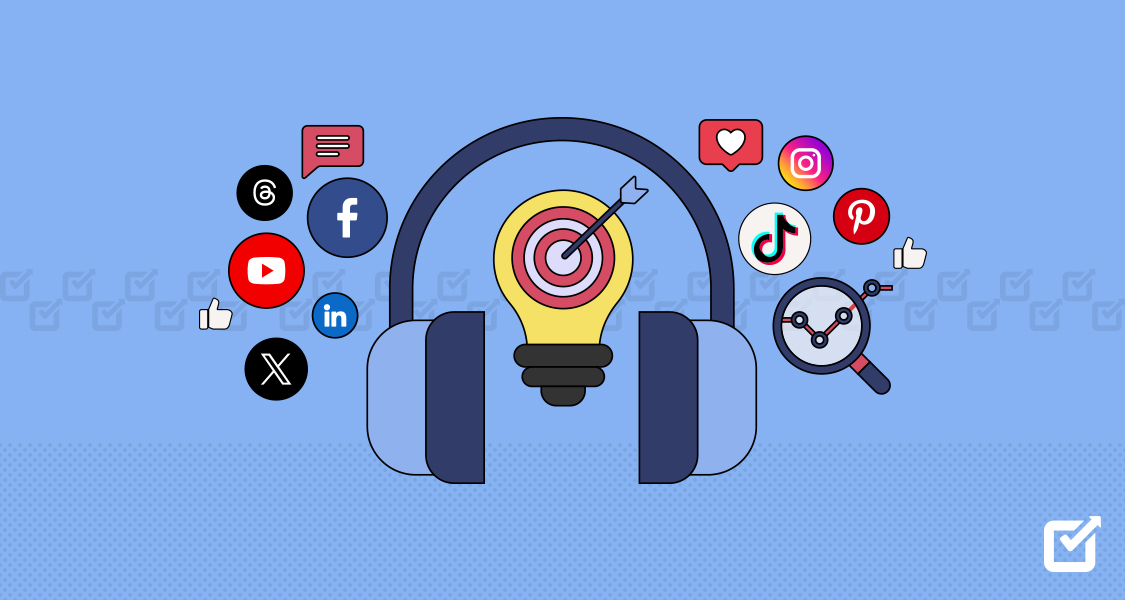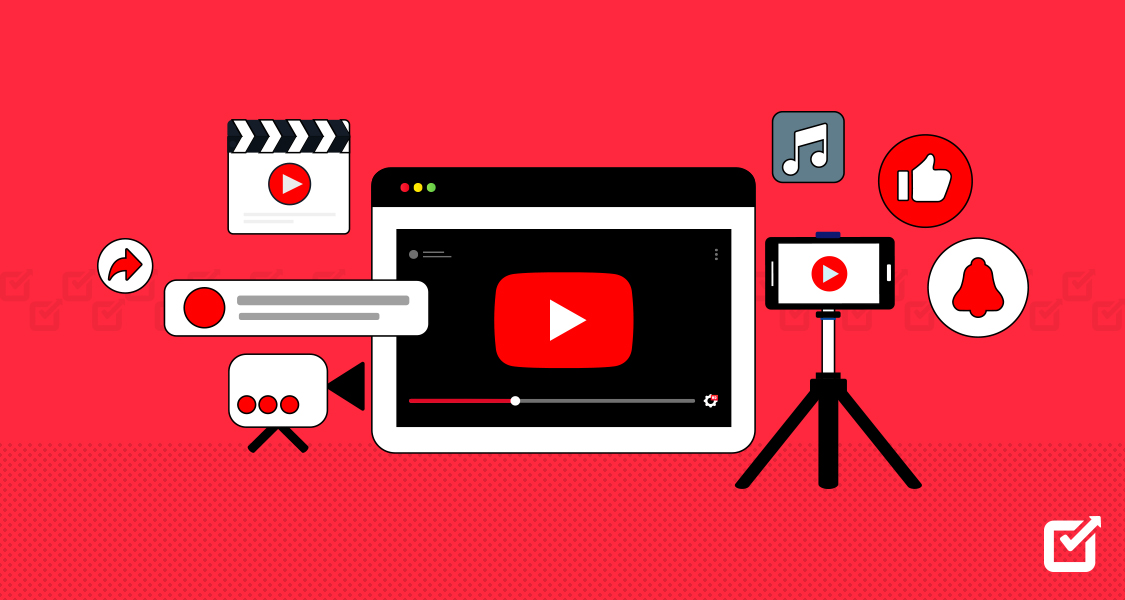In the world of social media listening, your brand’s image can quickly rise or fall based on what people say about it on social media. Positive comments can boost your reputation, while negative ones can harm your business. All the years you spent building trust and success can vanish because of one unchecked social media post. That’s where “social media listening” comes in.
Think about how good of a listener you are in regular conversations. Now, think about listening to what people are saying about your brand online. Social listening is like tuning in to what your customers are talking about without having to search endlessly for answers.
According to 51% of social media listening professionals, they prefer opting for relevant information resources when working on solving queries.
Social media makes customer conversations really open and clear. People share what they care about, what makes your company stand out, the problems they face, and what kind of marketing messages they like. The tricky part is that many brands are guessing instead of really listening.
So we are here to sort it all out, from understanding the basics to introducing you to some handy tools, as well as letting you in on our top tips and tricks for using social listening for your business. Let’s get going, then.
Part 1: Understanding Social Media Listening
Let’s get to it!
What is Social Listening
Social media listening is like eavesdropping on what people are saying about your brand or things related to your business on social media. It means paying attention to comments, discussions, and mentions across different social platforms to understand what your customers, competitors, and others are talking about. This practice goes beyond just tracking direct mentions of your brand; it includes gaining insights into industry trends, customer sentiments, and any new issues.
By using social media listening tools, businesses can keep a finger on the pulse of online discussions. This makes it possible for them to identify opportunities, address customer concerns, and stay informed about new market trends. Basically, social listening helps companies make decisions that are based on facts, refine their marketing strategies, and engage with their audience in a much more effective way. It’s an important part of maintaining a positive brand image, improving customer satisfaction, and staying competitive in the social media industry.
Featured Article: How to Track Essential TikTok Analytics in 2024
What’s the Difference Between Social Listening and Social Monitoring?
Let’s outline the key differences between the two!
Approach and Nature
Social media monitoring is like a quick response team. It looks out for specific mentions of your brand and lets you know immediately when it’s being talked about. It’s good for dealing with problems right away. On the other hand, social media listening is more discrete. It pays attention to all online talks about your brand, not just direct mentions. It looks at what people are saying about related topics, competitors, or industry trends and wants to know why they’re saying that.
Scope and Focus
Social media monitoring, often known as brand monitoring, revolves around specific mentions of a brand. It is particularly useful for taking care of any negative remarks or complaints but provides a limited perspective by focusing on immediate mentions. On the other hand, social listening offers a wider picture, noticing all online discussions related to a brand, products, industry, and competitors. This broader focus provides some very important insights that go beyond immediate mentions.
Time and Strategy
Social monitoring acts fast. It’s about quick responses and dealing with things immediately. However, social media listening takes a bit more time. It’s about understanding why things are happening and making smart decisions for the long term. It’s like having a plan rather than just reacting to what’s happening right now.
Featured Article: How to Make a YouTube Video in 2024
How Can a Social Listening Strategy Help Your Business
There are many ways to help your business grow, some of which are:
Understand Your Audience
A social media listening strategy allows you to grasp what your audience truly cares about. By analyzing their conversations, preferences, and concerns, you gain valuable insights into their needs and interests. This understanding helps you in adapting your products or services to suit their expectations better.
Business and Product Intelligence
Through social media listening, you gather important intelligence about your business and products. You can track feedback, identify areas that need improvement, and even get ideas for a new product based on what customers are saying online.
Crisis Management
If you are actively monitoring social media conversations about your brand, you can detect any sign of a possible crisis early on. This early detection helps you to respond quickly, addressing issues before they get out of hand and therefore protecting your brand’s reputation.
Customer Relationships and Acquisition
Social media listening is a great source for building customer relationships. Engaging with your audience based on their discussions helps build trust and loyalty. When you understand the needs of your audience, you can attract new customers through more targeted and relevant marketing efforts.
Collaboration Opportunities
Listening to social media discussions can open new and profitable collaboration prospects. Identifying the right influencers, potential partners, or opportunities for partnership based on online conversations can be a great tool for your business.
Competitor and Industry Trends
A social media listening strategy provides insights not only into your brand but also into competitors and industry trends. Understanding what others are doing or what customers think about competitors helps you stay competitive and adapt to industry changes.
Uncover Market Trends
Social media listening is the best way to stay informed about emerging market trends. Research says that It helps identify any changes in consumer preferences, new market openings, or emerging industry trends, which allows you to adjust your strategies accordingly.
Improve Campaign Targeting
Once you understand what resonates with your audience, social media listening improves your campaign targeting. Insights gathered with the help of social media listening can help in creating more effective and engaging marketing messages and content for specific segments of your audience.
Need an analytics tool to measure your UGC Performance?
Try Social Champ’s Analytics tool! With numerous options, weekly/monthly comparisons, tracking top-performing posts, and much more.
Part 2: Essential Social Listening Tools
Here are some tools that can help in social media listening
10+ Social Listening Tools That Will Do the Research For You
Let’s take a look at some good research tools here
Social Champ

Social Champ’s social listening
Social Champ has also launched a new social listening feature. You can monitor mentions of your brand or specific keywords across various platforms. This allows you to see what people are saying about you online and respond to comments and messages.
Social Champ’s listening feature comes with the ability to search for specific terms to pinpoint relevant conversations. Additionally, you can exclude keywords to filter out irrelevant mentions.
For instance, let’s say you’re a bakery named “Sweet Rolls.” You can set up monitoring for “Sweet Rolls” to see what people are saying about your brand. But to avoid getting flooded with mentions of generic cinnamon rolls, you can exclude the keyword “cinnamon” from your search. This way, you’ll focus on conversations specifically mentioning your bakery. This feature can help gain insights into brand sentiment and audience engagement.
Hootsuite

Hootsuite Hootsuite is a powerful tool for social media listening, which helps with the management and growth of relationships with your social media audience. The platform is based on a comprehensive dashboard for social media marketing and management, which allows you to monitor all your messages, comments, and direct mentions across multiple platforms.
But how does it help as a social media listening tool specifically? Well, that’s where its Analytics tool comes in. This tool goes beyond just simple tracking of your own social media interactions. It goes deeper into what people are saying about your brand, keeping you informed about discussions related to your industry and the activities of your competitors. When you use Hootsuite, you gain a detailed and up-to-date understanding of the online conversations that matter to your business.
Adview

Adview Meet Adview is a social media listening tool designed specially for monitoring Facebook and Instagram ads. Unlike many other social listening platforms, Adview is made to track and analyze the performance of ads, specifically on these two popular social media platforms.
One huge advantage Adview has over other social listening tools is its integration with Hootsuite. The merging of Adview with your Hootsuite dashboard gives you the advantage of managing and responding to comments across all your Facebook and Instagram ads conveniently from one account.
Adview doesn’t just stop at monitoring, though. It gives you detailed analytics on how high the engagement level of your ads is. This includes insights into which ads are receiving the most comments. By getting all that data, you become better equipped to make informed decisions and optimize your ad campaigns more effectively. With the ability to monitor up to three Facebook Ad Accounts across unlimited pages, Adview gives you a smooth and satisfactory experience for social listening, particularly focused on improving your performance on Facebook and Instagram ads.
Talkwalker

Talkerwalker Talkwalker is a helpful tool that keeps an eye on lots of different places on the internet, like blogs, forums, videos, and social media, all in one easy-to-use dashboard. It checks information from more than 150 million sources.
The tool is smart. It lets you filter and focus on the things that matter most to you, like specific messages or the people interested in your stuff. You can also set it up to tell you when there’s a sudden increase in people talking about your brand or certain words.
What’s cool is that Talkwalker doesn’t just count mentions. It helps you understand how people are interacting with your brand online, how many people see it, what they say, and if they like it or not. It’s a great social media listening tool for keeping an eye on your brand’s online world!
Synthesio

Synthesio Synthesio is another great social media listening tool for understanding what people are saying online. It doesn’t just listen broadly; it tunes into specific topics and groups of people, like sorting conversations by language, location, and more. One of its unique features is that it gives you reports with a social reputation score, showing how well you’re doing compared to others. So, it’s not just about knowing what’s being said but also having a score to see how you stack up against the competition. It’s a handy tool for businesses to really get what people are talking about online and make smart decisions based on that info.
Mentionlytics

Mentionlytics With Mentionlytics, you can easily track mentions, keywords, and even the sentiments expressed across various languages. This tool covers social platforms as well as blogs and news sites, to bring you a detailed overview of your brand’s online presence. And with its integration with Hootsuite, you can easily see all these insights on a single dashboard.
One unique feature of Mentionlytics is its ability to identify influencers on different social networks and online sources. This social media listening tool not only helps you pinpoint your top influencers but also helps you track keywords in multiple languages. And if you’re still not impressed, Mentionlytics can even detect the emotion conveyed in each mention, which gives you an even better understanding of how your brand is perceived.
Netbase Social Listening & Analytics

Netbase Social Listening & Analytics NetBase is based on NLP (Natural Language Processing) for locating and focusing on important conversations related to your brand.
What’s more, you can create streams to focus on specific topics relevant to your market and NetBase will get you information on those topics. With the help of NetBase, you can drive your customers towards purchasing decisions, improve your response time, make your content tailored for your audience and increase customer loyalty.
Audiense

Audiense Audiense is another good social media listening tool. It helps you figure out what any specific audience is talking about, what they like, and how they think. This info is handy for making marketing plans, understanding what customers feel, and creating new products. Audiense also has easy tools for ads and campaigns on social media, making it simple to connect with your audience. Plus, it helps you find the perfect match for your brand by understanding specific groups of people.
Digimind

Digimind Digimind stands out as one of the most convenient and effective social listening tools by offering a useful set of features for brand and market monitoring. With its advanced sentiment analysis, Digimind can accurately understand public opinion. Its real-time monitoring spans over 20 social media platforms like Facebook, Instagram, TikTok, and Twitter.
Digimind’s customizable dashboards and analytics help your businesses with important insights, which further aid you in tailored marketing strategies. Its user-friendly interface makes it a top choice for professionals seeking an effective, easy-to-use solution.
BrandMaxima Analytics

BrandMaxima Analytics BrandMaxima Analytics is designed to provide Twitter analytics. You can monitor in real-time any specific hashtag, keyword, event, or brand campaign.
BrandMaxima allows you to make these helpful infographics of the data it provides, which makes the whole process of understanding analytics even better.
Crowd Analyzer

Crowd Analyzer - Crowd Analyzeris yet another effective social media listening tool that enables you to monitor multiple channels at the same time. It tracks sentiment across Facebook, Twitter, and Instagram and extends its reach to online forums, news channels, and blogs. The integration of Crowd Analyzer with Hootsuite makes way for even better interaction. It enables you to Retweet, reply, or mention users directly from your Hootsuite dashboard. With Crowd Analyzer, you can easily guarantee that your brand is heard across many different online conversations.
Featured Article: How to Remove TikTok Watermark in 2024 [4 Easy Ways]
Part 3: Pro Tips for Effective Social Listening
Here are some tips to help you get started
7 Pro Social Listening Tips
Let’s take a look at these tips
Listen for the right words and topics
Start by finding words that matter for your brand. Keep an eye on your brand and product names, what your competitors are up to, important industry words, campaign names, and hashtags. Don’t forget to look out for spelling mistakes and short versions.
Listen in the Right Places
Figure out where people chat: LinkedIn, Twitter, Instagram, or Facebook. Adjust how you listen on each platform since discussions are different depending on the platform. This helps you talk to people naturally and decide where to advertise.
Narrow Your Search
Make your social media listening results better using advanced search techniques. If your business is local, focus on that area. Use smart search rules (like Boolean logic) to ensure you only see what matters.
Learn from the Competition
A great way to learn is to observe your competitors’ online strategies through social listening. Through a detailed analysis of their strategy, you can decide what resonates positively with the audience and learn from any error in judgment they have shown on their business plan. With the help of the social media listening tools we discussed above, you can gain insights into the demands of your audience and fill the gaps left by their lack of initiative.
Share What You Learn
A business and its employees are like a family. If one succeeds, the other does, too. The valuable information you gain from social media listening is for the entire team to benefit from. Make sure to share customer feedback, content ideas, or potential product improvements with customer service, content marketing, and product development teams. Working as one brain will guarantee a smooth strategy for your future business plans.
Keep Alert for Changes
Once you’ve been in the business long enough, you learn to understand the overall attitudes of your audience towards your brand, and it works like a machine afterward where you put out the content you already know your audience will love.
However, through keen observation, you should always be able to detect any sign of a shift in the audience’s sentiment toward your brand. The sooner, the better, should be your mantra in this regard. Knowing that something has changed and finding the cause of it should be your first priority as a social listening expert. And once you find out the reason, you must get to work to rectify that damage before the effects spread any further.
False Positives are Okay, within Reason
Every now and then, you might get some irrelevant posts in your search results unrelated to your brand. Those are false positives, and as long as they are on the low side (less than 5%), you shouldn’t stress too much about them. However, you should keep working on editing your search query to minimize these false positives.
Featured Article: How to Delete YouTube Channel in 2024
Part 4: Getting Started with Social Listening
Here are some steps to help you to begin the process
Get Started with Social Listening in 3 Easy Steps
Social media listening is a smart way for brands to analyze what customers are saying on a large scale. By understanding these conversations, businesses can create better and more effective strategies for social media marketing. If you want to know what your customers are thinking confidently, social listening is the key.
Step 1: The first part is all about monitoring. You should monitor all the social media platforms you are using for your business for any mention of your brand, rival companies, products, or any keywords that are related to your business by using any of the several social listening tools we mentioned above.
Step 2: Once you gather all the data, you must know how to use it to your maximum advantage. You can use this valuable data to help your business by satisfying any customers who have complaints about your business or by getting a reality check on your marketing strategies.
Step 3: Stay in tune with what people are feeling about your business industry on a bigger level so that you can detect any little shifts that may happen. You can track your audience sentiments via specific hashtags or keywords.
FAQ’s
1. What is an example of social media listening?
2. Who uses social media listening?
- Brands
- PR Agencies
- Customer service departments
- Influencers
- NGOs
- Research and Market Analysis Firms





















2 thoughts on “Mastering Social Media Listening: Strategies, Tools, and Getting Started”
Hello, I find your post very interesting. The information it contains
is very useful and entertaining, thank you for sharing your ideas with
us, it is very helpful!
Thanks for sharing this information. I really like your blog post very
much. You have really shared a informative and interesting blog post
with people.
Incredible guide! The article masterfully delves into social media listening, offering both strategies and tools. A must-read for those aiming to elevate their online presence!